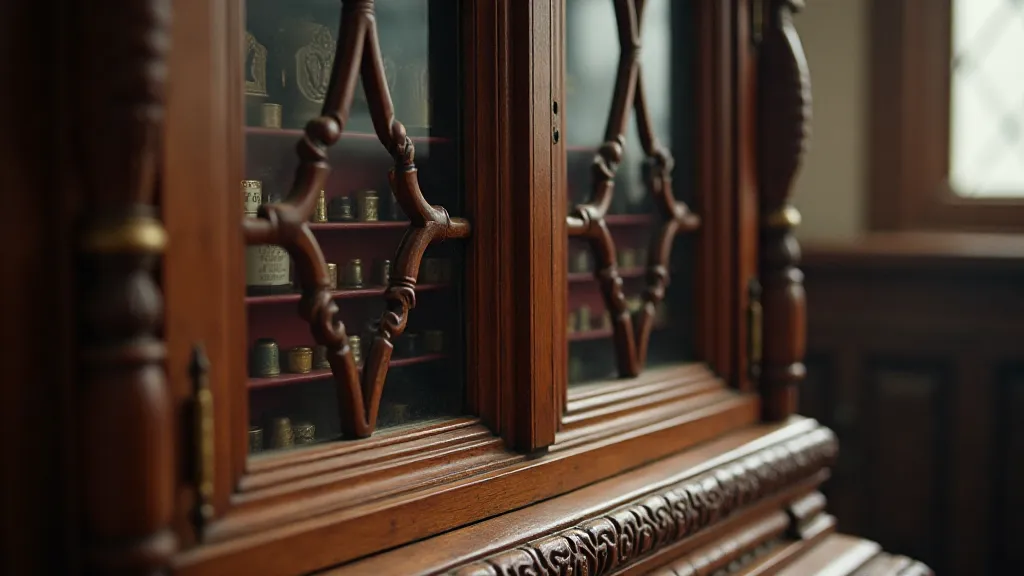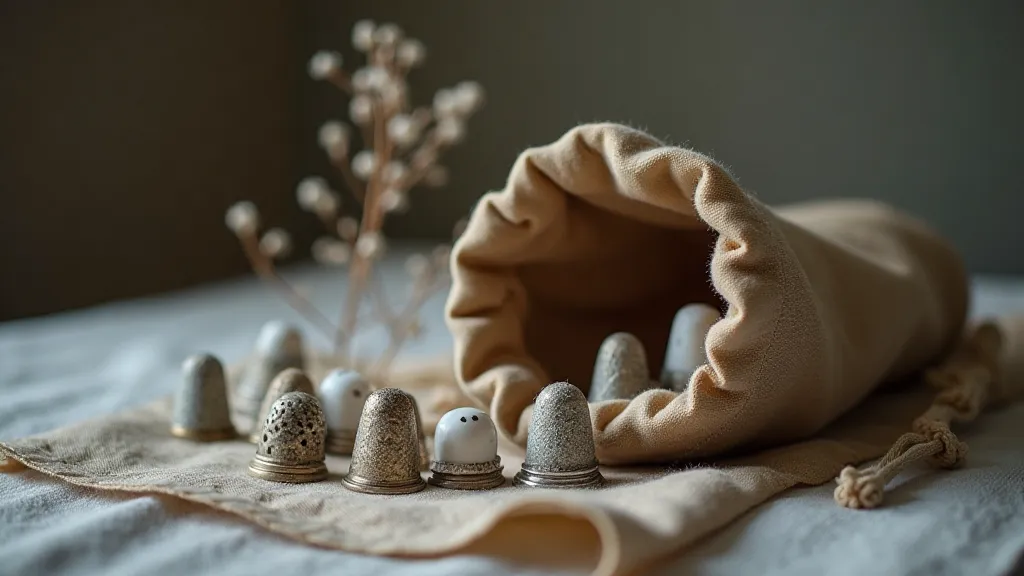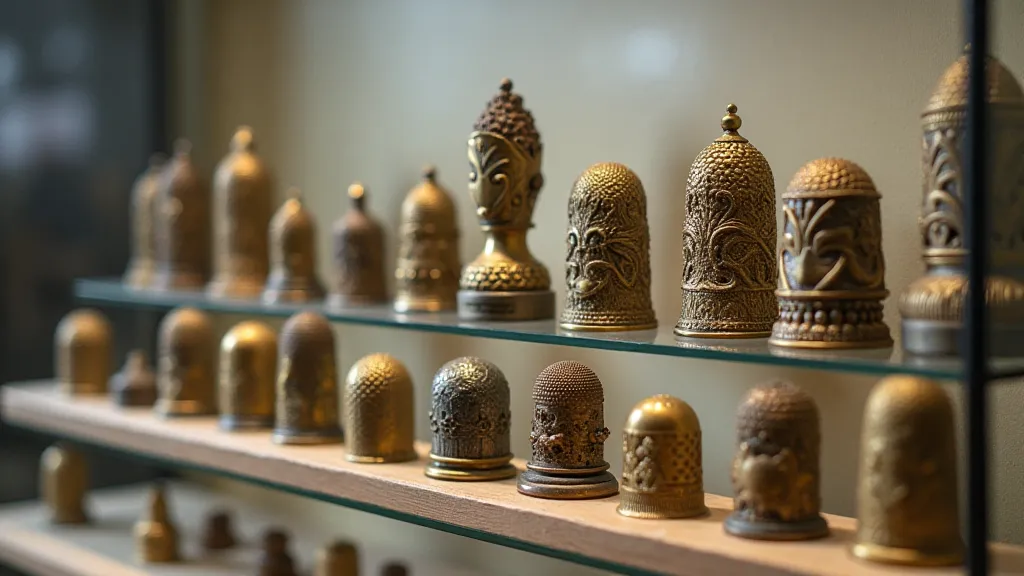From Parlor to Pocket: Tracing the Evolving Portability of Thimble Collections
The quiet click of a needle through fabric. The almost meditative rhythm of sewing. For centuries, the humble thimble has been an indispensable companion to this process, a tiny shield against the constant friction of the needle. But the story of thimbles isn’t solely about sewing; it’s about history, craftsmanship, and how our very notions of personal space and cherished possessions have shifted over time. And a powerful way to understand that evolution is by examining how thimbles were stored and displayed – how their portability changed, reflecting a wider societal transformation.
Imagine, if you will, a Victorian parlor. It wasn's merely a room; it was a performance space, a statement of wealth and social standing. And within that space, sewing was a common, often collaborative, activity. Women would gather, needles flashing, creating intricate samplers, elegant gowns, and cozy quilts. Their thimble collections weren’t scattered haphazardly; they were likely housed in ornate, purpose-built cabinets or displayed within velvet-lined boxes. These weren’t just containers; they were miniature showcases, testaments to the owner's refined taste. Think heavy mahogany, inlaid with mother-of-pearl, or delicate porcelain boxes painted with pastoral scenes. These weren’t meant to be carried about; they were meant to be admired, a part of the parlor's overall ambiance. My grandmother, a fervent collector, told me stories of her own great-grandmother, a woman who owned a particularly grand thimble cabinet, a family heirloom passed down through generations.

Early thimble storage often reflected the collective nature of sewing. Children, apprentices, and even household staff might share a single box or container. The thimbles themselves were often functional, made of materials like pewter, horn, or early forms of silver. Decoration was simple, sometimes just an engraved initial or a small floral motif. A mother might have passed down a favorite pewter thimble to her daughter, instilling a sense of connection and continuity through this tiny object. You can almost feel the warmth of shared creativity and the quiet hum of a family working together. The craftsmanship involved in creating these early thimbles, and the broader field of textile creation, evokes a sense of the vanishing art of hand-sewn textiles and the companionship that thimbles offered – an aspect explored more deeply in Echoes in Silver: The Silent Narratives of Forgotten Hands. The stories these thimbles tell offer glimpses into the past, highlighting how much we’re connected to the history contained within seemingly small objects.
The Rise of the Personal Collection
As the 19th century progressed, and the Industrial Revolution began to reshape society, the notion of personal space and individual ownership started to solidify. The grand parlor began to shrink in importance relative to the increasing prevalence of more private domestic spaces. Sewing transitioned from a largely communal activity to a more solitary pursuit. This shift is mirrored in the evolving way thimble collections were stored. The bulky cabinets were gradually replaced by smaller, more portable containers. Jewelers began to recognize the growing market for specialized thimble boxes, often constructed from silver, silverplate, or even leather. The increasing focus on individual expression and the allure of incorporating precious materials also led to a new appreciation for the artistry in even the most functional objects, as explained in The Jeweler’s Secret: How Precious Stones Elevate the Humble Thimble.
The rise of the middle class also contributed to this change. With increased disposable income, individuals had more freedom to pursue hobbies and accumulate possessions. Thimble collecting, once a rather unassuming pastime, began to gain traction as a recognized hobby. Specialized catalogues appeared, showcasing a wider variety of thimbles and providing information on their history and value. People began actively *seeking* rare and unusual examples, fostering a sense of pride and ownership. The motivations behind collecting, and the almost obsessive nature that can arise in the pursuit of miniature perfection, are fascinating aspects of human behavior.
From Boxes to Pouches: The Age of Portability
By the early 20th century, the era of the large, stationary thimble cabinet began to fade. The Edwardian period saw a surge in popularity for smaller, more intimate storage solutions. Velvet-lined boxes, often embossed with intricate designs, became the norm. These were easily placed on a dressing table or tucked away in a sewing basket. Even more significantly, small, drawstring pouches made of fabric like silk or velvet emerged as a popular choice. These pouches allowed for a degree of portability previously unheard of.

This shift in storage methods underscores a significant change in lifestyle. Women were increasingly mobile, participating in a wider range of activities outside the home. They needed to be able to take their sewing supplies, and their prized thimble collections, with them. Imagine a woman attending a quilting bee, her precious thimbles nestled safely within a silk pouch, ready to be admired and shared. Or a traveler, keeping a few favorite thimbles tucked away in a travel sewing kit, a tiny reminder of home and comfort. The very act of collecting and displaying these objects is often tied to deeply personal memories and a desire to preserve the past - an understanding of which can illuminate the collector’s shadow.
The Modern Collector’s Landscape
Today, thimble collections can be found in a dizzying array of storage options. From simple plastic boxes to elaborate display cases, the possibilities are endless. However, the core essence of the evolving portability theme remains – a reflection of our changing relationship with possessions. While some collectors still cherish the idea of a formal display, many prefer the practicality and intimacy of smaller, more personal containers. Many now opt for padded display cases perfect for showcasing a few select pieces while protecting them from dust and damage. The reasons behind why some collectors find solace in creating a personal collection, however, go far beyond the simple desire to own pretty things, and hint at more profound psychological drives.

My grandmother, bless her heart, eventually transitioned from her grand Victorian cabinet to a series of smaller, padded display cases and velvet pouches. She confessed that she enjoyed being able to rearrange her collection and share her favorite pieces more easily with visitors. It was a poignant moment, witnessing the passing of an era, but also appreciating the enduring passion for these tiny treasures. She shared stories of the history behind many of her thimbles, tales that connect to A Pocketful of Memories: The Thimble’s Role in Migration and Storytelling, reinforcing the rich tapestry of history woven into each piece.
The increasing availability of mass-produced items has also impacted the way people view handmade objects. The unique charm and history associated with antique thimbles, often passed down through families, hold a special significance in a world saturated with disposable goods. This connection to the past and the desire to preserve traditional crafts contributes to the ongoing fascination with thimble collecting.
Furthermore, the emergence of online communities and social media platforms has fostered a global network of thimble enthusiasts. Collectors can now easily connect with one another, share their collections, and learn about rare and unusual pieces. These online spaces provide a sense of belonging and shared passion, extending the community beyond geographical boundaries.
The evolution of thimble collecting mirrors broader trends in consumerism and the pursuit of hobbies. What began as a practical necessity for sewing has transformed into a passion for collecting, preserving, and appreciating these tiny works of art. The humble thimble serves as a tangible link to the past, a symbol of creativity, and a reminder of the enduring human desire to create and connect.
The stories and histories connected to these collections reveal something more: a deep human longing for connection – to the past, to family, and to a craft that transcends generations. The evolution of storage, from the grand parlor displays to the portable pouches, isn’t just about practicality; it's a reflection of how we choose to hold onto those connections.





